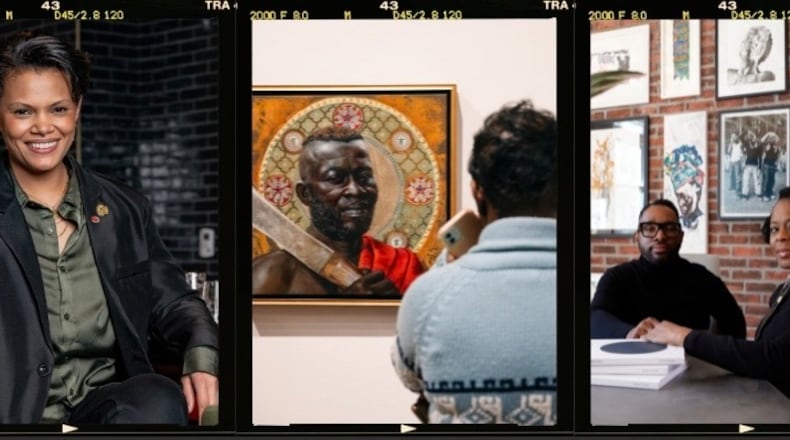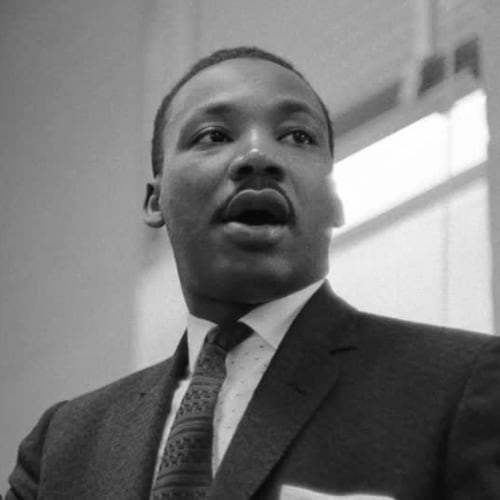In 2023, The Atlanta Journal-Constitution did a thing.
We produced, “The South Got Something to Say,” our first feature-length documentary under the newly-formed AJC Films.
Building on Atlanta and Georgia’s deep Black cultural roots, the film – directed by Ryon and Tyson Horne and written by me and DeAsia Paige - explored the history of hip-hop through the city’s massive influence on the genre.
But there was a moment late in the filming that struck me in a room at The Tabernacle, with cultural critic and curator Jason Orr, where he hosted so many of his legendary FunkJazzCafe events. He explained how today’s hip-hop was built on musical roots long-planted deep inside of Georgia’s red clay.
“Just imagine our Mount Rushmore. This is the cornerstone of all music,” Jason told us. “Little Richard. Otis Redding. James Brown. And Ray Charles. You gotta fix your clothes after that.”
While making the film, I was also making plans for the AJC’s annual Black History Month series.
I knew that the series, as it does annually, would follow the themes of the Association for the Study of African American Life and History, this year focusing on Atlanta and Georgia’s rich artistic and cultural heritage.
The ASALH was founded in 1915 by Carter G. Woodson, the father of Black History Month,
We were going to look at how Black people—through artistic and cultural movements like the Black arts, the Harlem Renaissance, hip-hop, and Afrofuturism — worked to preserve history and community memory as well as how they used the arts as a form of resistance and empowerment.
But at that moment, while Jason was fixing his collar, I knew what story I was going to assign first. And Bo Emerson’s amazing story about Georgia’s Mount Rushmore and how Little Richard, Otis Redding, James Brown and Ray Charles each rose out of crippling poverty to change American music is but one of the incredible stories we told this year.
Credit: Ric Watkins / AJC
Credit: Ric Watkins / AJC
We have been doing this for nine years now, and this year’s version might be our best effort yet. There were 29 days in February this year, but we produced 34 original stories, our most ever.
We got contributions from at least 20 full-time reporters, our intern, two photographers who wrote original stories to go with their images, and a best-selling novelist.
Nearly every photographer, editor, designer, artist, social media specialist and curator on the staff contributed to the series.
They came up with stories on:
Atlanta’s legendary old school hangout, Ellery’s, where old heads might go to listen and dance to a playlist that includes Georgia’s Mount Rushmore.
Credit: Olivia Bowdoin
Credit: Olivia Bowdoin
On the 50th anniversary of Clark Atlanta University’s WCLK radio station, one of the most important HBCU stations in the country.
Credit: Jason Getz
Credit: Jason Getz
On the Black Streaks, one of the earliest teams of Black motorcycle racers.
Credit: Richard Watkins
Credit: Richard Watkins
And the “fresh spring start,” for the Hammonds House Museum.
Credit: arvin.temkar@ajc.com
Credit: arvin.temkar@ajc.com
Here is a look back with all of the links in case you missed something:
The Word
We kicked off the series with a story that argues how every literary form that Black people have produced in the Americas since at least the 18th century descends from slave narratives.
Credit: Documenting the American South
Credit: Documenting the American South
Those narrative strings include father and son authors Michael and Matthew Carson, who donated 1,000 copies of their latest book “Unsung African-American History Makers: Unknown Hidden Figures and Their Stories,” to visitors of the National Center for Civil and Human Rights.
The Voices
As we recount in the documentary, Atlanta is now the undisputed capital of hip-hop music. Much of that charge was led by OutKast and we go back 30 years to listen to the influence of their groundbreaking, debut album “Southernplayalisticadillacmuzic.”
But before OutKast, there was opera legend Mattiwilda Dobbs, the aunt of the city’s first Black Mayor Maynard Jackson, and a world-renowned coloratura soprano, whose vocal technique was described as pure and resonant as a bell.
Credit: Dobbs and Michelle Jordan
Credit: Dobbs and Michelle Jordan
Before Mattiwilda was Thomson’s Blind Willie McTell, the 12-string blues master, who left a lasting musical legacy that is still being felt. Including the iconic Virginia-Highland blues venue that bears his name.
And while she was not from Georgia, we hear how the inimitable Celia Cruz helped popularize Afro-Caribbean rhythms, from the Queen of Salsa’s niece Linda Becquer-Pritchett, a member of the City of South Fulton city council.
Credit: Jenni Girtman
Credit: Jenni Girtman
But coming back forward, in a city that once upon a time produced TLC, Xscape and Blaque, we ask the question “Whatever happened to girl groups?”
The Canvas
For the series, we toured the art museums and Spelman College and Clark Atlanta University to view their rare and incredible collections.
Credit: Olivia Bowdoin
Credit: Olivia Bowdoin
We visited the homes of some of Atlanta’s biggest art collectors, all of whom happen to be Black and sat down with some of the city’s hottest Black fashion designers.
We went to Savannah to marvel at public art courtesy of sculptor Jerome Meadows.
Credit: Stephen B. Morton for The Atlanta Journal Constitution
Credit: Stephen B. Morton for The Atlanta Journal Constitution
We also learned that a canvas can be anything.
From a concrete or brick wall, which is how the United Kings sparked the city’s hip-hop and street art legacy.
To the plates influenced by the late Chef Darryl Evans. To the drinks being created by Mona Allen, one of Georgia’s only Black sake sommeliers.
The Performances
From the silver screen, we explored the complicated legacy and resurrection of Hattie McDaniel, the first Black person to be nominated for and win an Academy Award. We looked back at “Something Good-Negro Kiss,” the earliest-known representation of Black people on the screen showing love and affection, in an era dominated by racist stereotypes.
On the small screen, we have fun with Nat Geo Wild’s “Critter Fixers: Country Vets,” two Macon-based veterinarians who have been nominated for an NAACP Award.
And in theater, we ask why it took so long for a Black man to play Othello on stage.
The Mentors
This year, for the first time, we worked to tell more personal stories. We did that by having writers sit down with influential achievers, with shared backstories, to hear how they reached their goals.
So we had our intern and Morehouse College senior Auzzy Byrdsell walk around campus with Olympic and Morehouse legend Edwin Moses.
AJC County reporter Adrianne Murchison visited with novelist Tina McElroy Ansa, who also happens to have been the first Black woman to ever work for The Atlanta Journal.
Credit: Stephen B. Morton for The Atlanta Journal Constitution
Credit: Stephen B. Morton for The Atlanta Journal Constitution
Tayari Jones, the Charles Howard Candler Professor of Creative Writing at Emory University, whose latest novel, “An American Marriage,” was selected by Oprah Winfrey to be a part of her acclaimed book club, wrote on the transfixing and transformative legacy of Spelman’s “Sister President,” Johnnetta Cole.
Credit: Julie Yarbrough
Credit: Julie Yarbrough
Dark History
But not everything was rosy. History is living and sometimes dark and complicated -- like the harrowing story of Hubbard Pryor, who escaped slavery to fight for the Union, only to be recaptured.
Credit: U.S. National Archives
Credit: U.S. National Archives
Or the bleak future of Herndon Stadium, the once-proud home of the Morris Brown Wolverines.
Or the story about researchers who have found toxins in the blood of Brunswick residents, mostly Black, who live near factories.
Credit: Stephen B. Morton for The Atlanta Journal Constitution
Credit: Stephen B. Morton for The Atlanta Journal Constitution
There is also the fascinating and little-known story of MARTA’s “Maid Routes,” which quietly shuttled the city’s Black and Hispanic domestic workers to the Buckhead mansions they cleaned.
The Mourners
In one of the most poignant pieces of the whole series, Arvin Temkar spent more than three months following Willie A. Watkins, one of Atlanta’s most prominent funeral home directors.
Credit: arvin.temkar@ajc.com
Credit: arvin.temkar@ajc.com
Arvin wanted to go behind the tears and explore the pageantry and celebration behind Black funerals. He provided the words for the story, but his images, in stark - but beautiful black and white - tell the story of Black Atlanta.
Sue
As we have done every year, we try to end the series with a sense of hope, usually profiling someone who is beginning to make history and contribute to Atlanta’s community growth. This year, we ended on someone on the inside, with a clear view of who that new generation of history makers is - Sue Ross.
For more than five decades, Sue - as everyone calls her - has roamed Atlanta taking thousands of pictures of Atlanta’s rich and textured Black life. She is always behind the camera. AJC photographer Natrice Miller finally put Sue in front of the camera.
And it was something good.
If you want to check out the whole series, plus read every story we have published over the last nine years, click here.
Now we rest and get ready for next year’s 10th anniversary.
About the Author
The Latest
Featured















